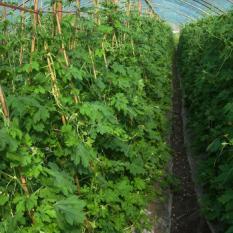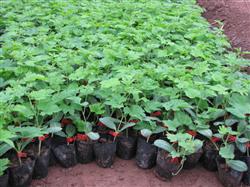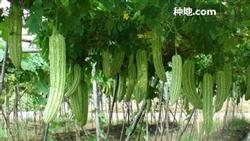How to make balsam pear mature prematurely in greenhouse?

How to make balsam pear mature prematurely in greenhouse? Balsam pear is a typical heat-resistant summer vegetable. It takes about 7 months for open field cultivation to be on the market, and it can be listed more than a month earlier for cultivation in greenhouse. Selection of varieties. The excellent balsam pear varieties suitable for greenhouse cultivation are: Sichuan Changbai balsam pear, Hunan Lanshan balsam pear, Jiangxi Yangzizhou balsam pear, Ji'an white balsam pear and so on. Cultivate strong seedlings. In the first and middle of January, the seedlings were raised in the electric hotbed in the greenhouse, and the root was protected by nutrition bowl. Balsam pear seeds have a tortoise shell, need to be washed with boiling water or warm water, stir until not hot, soak at room temperature (about 25 ℃) for 24 ℃ for 28 hours, take out, wash, wrap, and sprout for 10 days under the condition of 30 ℃-35 ℃. About 200 grams are needed for every 667 square meters (1 mu) of greenhouse. Colonization. When the seedlings had 5 leaves in mid-late February, they were planted on the high border with a width of 1.2m in Liangou, and planted in a row with a spacing of 0.5m, with 1100 plants per 667m2. Management after planting. 1. The greenhouse controls the temperature and humidity. After planting, the seedling stage was closed to raise the temperature and promote the slow seedling. Keep warm and freeze-proof before the end of March, and be properly ventilated during the day. Before the end of April, pay attention to heat preservation at night and ventilation and dampness during the day. After May, ventilation is mainly used to cool and dehumidify. Ventilation begins when the noon temperature reaches 30 ℃, and stops when the temperature in the shed drops to 25 ℃ in the afternoon. In June, the apron membrane at the bottom of the greenhouse was removed and the roof film was retained to protect against rain. two。 Fertilizer and water management. Balsam pear likes fertilizer and dampness. under the condition of sufficient water and fertilizer, the yield is high and the quality is good. On the basis of applying sufficient base fertilizer, fertilizer and water management must be strengthened. Although balsam pear is tolerant to fertilizer, it is weak at seedling stage, and slightly thicker fertilizer will burn the seedlings, so topdressing should be light in front and heavy in back. After planting, 10% dilute dung water can be used at the slow seedling stage. During the vigorous growth period of stems and leaves and the flowering and fruiting period, heavy fertilizer should be applied twice, each time 25 Mel 30 kg of compound fertilizer per 667 square meters, and after each harvest, 0.2% urea and 0.3% potassium dihydrogen phosphate mixture should be used to top fertilizer. The characteristic of water management is that the moisture can be properly controlled and the soil can be kept moist in the early stage of slow seedling growth. Ditches should be cleared and drained in time in the rainy season. 3. Pruning, building fights. Balsam pear has strong branching and high cultivation density in greenhouse, which is more likely to produce overdense vine leaves, poor ventilation and light transmission, empty consumption of nutrients, affecting yield and commerciality. Therefore, it is necessary to strengthen pruning and cultivate it with stents. When drawing long tendrils, build a herringbone frame or arch or trapezoid frame in time to draw the vine on the shelf. Balsam pear is mainly composed of main vines, and lateral vines should be removed. Under the condition of sufficient fertilizer and water, several lateral vines can also be left in the later stage to increase yield in the later stage. At the same time, the old and diseased leaves should be removed at any time in the middle and later stage of production to facilitate ventilation. 4. Artificial pollination. Due to the low temperature of early maturing cultivation of balsam pear, less door opening, small air flow in the shed, and few insect pollination, it is difficult to pollinate naturally, so it is necessary to pollinate artificially and smear female pedicel or young gourd with 20Mel 40mg / L 2min 4Mel D to increase the fruit setting rate of balsam pear, overcome melons, promote melon expansion and increase yield. Click to get more balsam pear planting techniques click to get more vegetable planting techniques
- Prev

How to accelerate the germination of balsam pear seeds
15-20 days before sowing, deep ploughing and ploughing, combined with ploughing, 3000 kg-4000 kg of rotten barnyard manure per mu, and 15 kg-20 kg of ternary compound fertilizer. The soil and greenhouse were fully sterilized by sunlight exposure and high temperature greenhouse after drying the field for 7-10 days and then sealing the greenhouse for 5-7 days. After holding the ground flat.
- Next

How can you improve the fertilizer absorption rate of bitter gourd?
How to manage balsam pear can be fruitful? Please guide seed soaking and sprouting to select early and middle mature large balsam pear varieties with exuberant growth, strong fruiting power, full waist and fruit length of more than 25 cm. Seed dressing with new high fat film (which can be mixed with seed coating agent or pesticide) can ward off underground diseases and insects, isolate virus pollution and strengthen seed respiration.
Related
- Where is it suitable to grow horseradish in China? it is expected to see the middle altitude horseradish in Alishan.
- How to prevent tomato virus disease reasonably? (Control methods included)
- Many people like to plant towel gourd on the balcony. What are the main points of this method and management?
- What crops can chili peppers be mixed with?
- Fertilization techniques and matters needing attention in Tomato
- What are the grafting techniques for peach seedlings in spring?
- Harm and control methods of root swelling disease of Chinese cabbage
- What are the pests of sweet potatoes? How to prevent and cure it?
- Symptoms, causes and Control methods of navel Rot in Tomato
- The cause of "Cucumber rotten bibcock" in Farmers' planting Cucumber and its Control Plan

